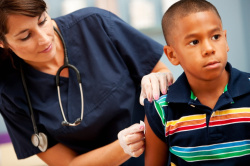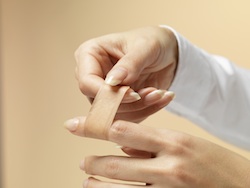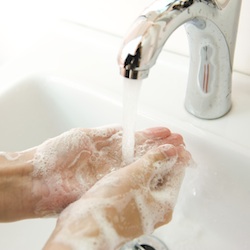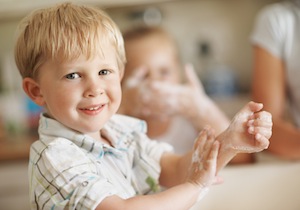Sepsis can be caused by any type of infection: bacterial, viral, fungal, or even parasitic. Sepsis prevention is only possible by preventing infections with good and consistent hygiene and avoiding people with infections. Other infections can be prevented through the use of vaccinations.
Infection prevention is sepsis prevention!™

Vaccinations for infection prevention
Viral infections, such as influenza (the flu) chicken pox, and COVID-19 are caused by viruses. Viruses are microscopic organisms that must live inside a living host, such as humans. Although each virus is different, viruses generally don’t survive for long outside the host.
Usually when you have a viral illness, your body produces antibodies that keep you from getting the illness again – they make you immune. Vaccines have been developed for many prevention of many viruses, such as chicken pox (varicella), tetanus, and polio. These vaccines, sometimes called immunizations, trick your body into thinking that it has been infected with the virus – and then makes you immune to actually getting the illness. By preventing illness, vaccines prevent sepsis deaths.
Visit Sepsis and Prevention: Vaccinations to learn more about vaccines, how they work, and why they are important.
Caring for wounds
Every cut, scrape, or break in the skin – including surgical incisions – can allow bacteria to enter your body that could cause an infection. For this reason, infection prevention begins with ensuring that all wounds be cleaned as quickly as possible and be kept clean as they heal. They should also be monitored for signs of an infection.
Cleaning open wounds:
- Always wash your hands before touching an open wound. If possible, wear clean disposable gloves.
- If the wound is deep, gaping, or has jagged edges and can’t be closed easily, it may need stitches. See your healthcare provider as soon as possible.

- If the wound does not appear to need stitches, rinse it and the surrounding area with clean (not soapy) water. Gently running water over the wound can help remove any dirt or debris that may be inside. If you believe that there is still debris in the wound, this should be checked by a healthcare provider.
- If desired, apply an antibiotic cream or ointment.
- Cover the wound to protect it from dirt and from rubbing against clothing.
- Watch for signs of infection: redness around the wound, skin around the wound warm to touch, increased pain, and/or discharge from the wound. Consult your physician or nurse practitioner if you suspect you may have an infection.
Blisters: If you have a blister, do not pop it or break it. The blister is a protective barrier and breaking it introduces an opening in your skin. If the blister does break, treat it like an open wound, and keep the area clean and monitor for signs of infection.
Treating infections
Bacterial infections
Bacteria can cause infections in many parts of the body, such as a cut or bug bite on your arm, your kidneys or bladder, even your lungs (pneumonia). If you have been diagnosed with a bacterial infection, you will likely be prescribed antibiotics for treatment. Antibiotics are medications that kill bacteria or stop them from reproducing.
Some antibiotics work against several types of bacteria, while others are for specific bacteria only. Partly because of overuse and misuse of these medications, some bacteria are becoming resistant to certain antibiotics. This is making it harder to treat infections. For this reason, it is essential that people take antibiotics only when necessary and exactly as prescribed.
What to do when you are prescribed antibiotics
- Follow the instructions regarding how the medication should be taken – with or without food, before or after meals.
- Take it on time (example: once a day, every six hours)
- Finish the full course (7 days, 10 days, etc.), even if you feel better earlier. The symptoms will disappear before the bacteria have been completely eliminated.
- Store the antibiotics as directed to preserve its strength.
What not to do with antibiotics
- Do not ask your physician or nurse practitioner for a prescription for an infection not caused by bacteria. Antibiotics do not work on viruses, such as colds or the flu, or other illnesses not caused by bacteria.
- Do not take someone else’s antibiotics, even if you do have a bacterial infection. It may not be the correct type or dosage, or it may have expired. It can be dangerous to take expired antibiotics.
- Antibiotics are not usually taken for infection prevention, but there are situations where this may be necessary. If your doctor prescribes antibiotics for prevention, follow the instructions carefully.
Viral infections
Most viral infections run their course without treatment, but some viral infections may be treated with anti-viral medications. If you are ill and don’t seem to be getting better, are getting worse, or are developing new symptoms, are having difficulty breathing, or you are concerned, please consult your healthcare professional. Sometimes medications may be prescribed for the symptoms caused by the virus.
Fungal and parasitic infections
Infections caused by fungi or parasites must be treated with specific medications that will eliminate the cause.
Important Infection Prevention Tool: Hand washing
Washing our hands is a simple task that we all do every day, several times a day. However for hand washing to be effective, it needs to be done properly and possibly more frequently than many people do already.

Generally, to wash your hands well, you simply need to use running water (to help wash the debris from your hands), lather your hands well (making sure to rub between each finger and under your nails), and dry your hands thoroughly with a clean towel. It is best if you remove your rings before washing your hands.
If you are using a hand sanitizer (waterless cleanser), use the same motions of rubbing your hands together, in between your fingers and remembering the tops of your hands and your thumbs. Your hands should be dry before touching anything.
If you’re wondering whether to use a waterless cleanser or soap and water, the general belief is that soap and water are best for hands that are visibly dirty or after activities, such as toileting. Hand sanitizers are good for when hands are not visibly dirty, but you know they need to be cleaned.
Teaching children to wash their hands.
Children have many things they want to do and washing their hands may not be something they see as important. However, they do need to learn how to wash their hands properly and when they should be washed.

Obviously, children should wash their hands when they are dirty, but here is a list of other times when washing their hands is a must:
- Before eating or handling food
- After using the bathroom
- After blowing their nose or coughing
- After touching pets or other animals
- After being outside the home, such as playing outside, going to school, or shopping
For people caring for or living with someone who is immunocompromised.
Someone who is immunocompromised has a weakened immune system, which makes it easier for them to develop infections and they have a harder time fighting them. When caring for or coming in contact with someone who is immunocompromised, it’s important to reduce the infection risk as much as possible, so the routine for washing your hands is stricter. While it may take a little longer to go through the steps, they are important in limiting the chances of transferring an infection to someone who may have a hard time fighting it.
- Remove rings and watches so you can clean the areas where they rest against your skin.
- Wet your hands with warm running water.
- Using soap, preferably liquid, rub your hands together to make a lather. Make sure that your fingertips rub into the areas between the fingers (webs) of the opposite hand.
- With each hand, wash the top of your other hand, not just the inside (palms). Don’t forget the thumbs, which are often neglected. Clean under your nails and let the water run under them as well.
- Go up to your wrists when washing.
- Hand washing should take at least 10 to 15 seconds. This is about how long it takes to sing “Happy Birthday,” twice quickly or once slowly.
- Rinse your hands well and then dry with a clean towel. Pat them gently rather than rubbing vigorously, to protect your skin from becoming irritated.
- Use this towel to turn off the tap, to prevent recontaminating your hands.
There are other situations that can also increase infection risk, like malnutrition. A healthy diet helps your immune system function.
Not all infections can be prevented and as a result, not all cases of sepsis can be prevented. However, by following these basic rules, you can decrease your risk of becoming ill.
Updated January 13, 2022.





























